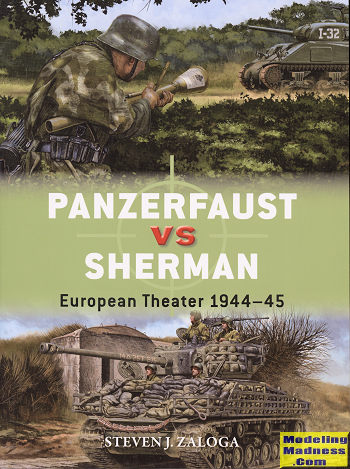 When the
Germans invaded the Soviet Union, they ran into the T-34 and KV series of tanks.
These were basically impervious to the anti-tank guns then in service and it was
a real shock and threat. Even the larger anti-tank guns were not always as
effective as one would like. This wasn't the first time the Germans had run up
against well armored tanks as they had to deal with British and French infantry
tanks in 1940, but the overwhelming victories of that time put the need to deal
with them on the back burner.
When the
Germans invaded the Soviet Union, they ran into the T-34 and KV series of tanks.
These were basically impervious to the anti-tank guns then in service and it was
a real shock and threat. Even the larger anti-tank guns were not always as
effective as one would like. This wasn't the first time the Germans had run up
against well armored tanks as they had to deal with British and French infantry
tanks in 1940, but the overwhelming victories of that time put the need to deal
with them on the back burner.
The thing about penetrating a lot of armor with a
standard AP round is that the thicker the armor the much larger the charge has
to be to penetrate it. It ends up with a factor of diminishing returns as armor
gets thicker. However, there was a fix. That was the development of shaped
charges. It was discovered that these charges, which were being used by
engineers to destroy bunkers and the like, were able to penetrate a very thick
amount of concrete. These charges basically concentrated all the blast into a
small point, turning a metal shield inside the charge into a high speed and
incredibly hot plasma jet that penetrated the wall. The super-hot spall created
once the jet penetrated was usually enough to destroy whatever was inside.
This sort of thing was too large for a standard tank
shell to be effective so it was determined that some sort of propelled charge
was needed. After much trial and error, as well as picking up some US bazookas
in North Africa, two methods of delivering this charge were developed. One was
the Panzershrek which was basically a larger form of bazooka and was developed
in several sized, each larger size being able to propel larger warheads a longer
distance. The other was the Panzerfaust which was a disposable munition that was
really only good for a short distance (about 100 feet) and required a lot of
courage to get in place to use. These two weapons were, like the bazooka, fairly
short range and most effective in ambush situations. They were rarely used on
the Eastern Front due to the open spaces.
The greatest use was in European theater. Initially,
these were very effective against the Sherman which simply did not have the
armor to protect the crew from a hit. However, right after Normandy the number
of these weapons was not as great as later on. Still, there were a myriad of
attempts to do something to enhance protection against these. Things like
sandbags, additional welded on armor plate, track links and concrete were tried
with various levels of success, though nothing was really able to be 100%
effective.
In this book, the author takes a look at the development
of the weapons, their use and their effect. On the other side of the situation
was the attempts by US tank units in both an official and unofficial manner to
provide protection against these weapons. The book also provides several major
combat operations where the two adversaries were present and the results of
those engagements. It makes for a fascinating read on a subject that isn't all
that well known to most enthusiasts. A well done read and very much worth
picking up.
October 2019
Copyright ModelingMadness.com. All rights reserved.
For more on the complete line of Osprey books,
visit www.ospreypublishing.com .
If you would like your product reviewed fairly and quickly, please
contact
me or see other details in the
Note to
Contributors.
 When the
Germans invaded the Soviet Union, they ran into the T-34 and KV series of tanks.
These were basically impervious to the anti-tank guns then in service and it was
a real shock and threat. Even the larger anti-tank guns were not always as
effective as one would like. This wasn't the first time the Germans had run up
against well armored tanks as they had to deal with British and French infantry
tanks in 1940, but the overwhelming victories of that time put the need to deal
with them on the back burner.
When the
Germans invaded the Soviet Union, they ran into the T-34 and KV series of tanks.
These were basically impervious to the anti-tank guns then in service and it was
a real shock and threat. Even the larger anti-tank guns were not always as
effective as one would like. This wasn't the first time the Germans had run up
against well armored tanks as they had to deal with British and French infantry
tanks in 1940, but the overwhelming victories of that time put the need to deal
with them on the back burner.